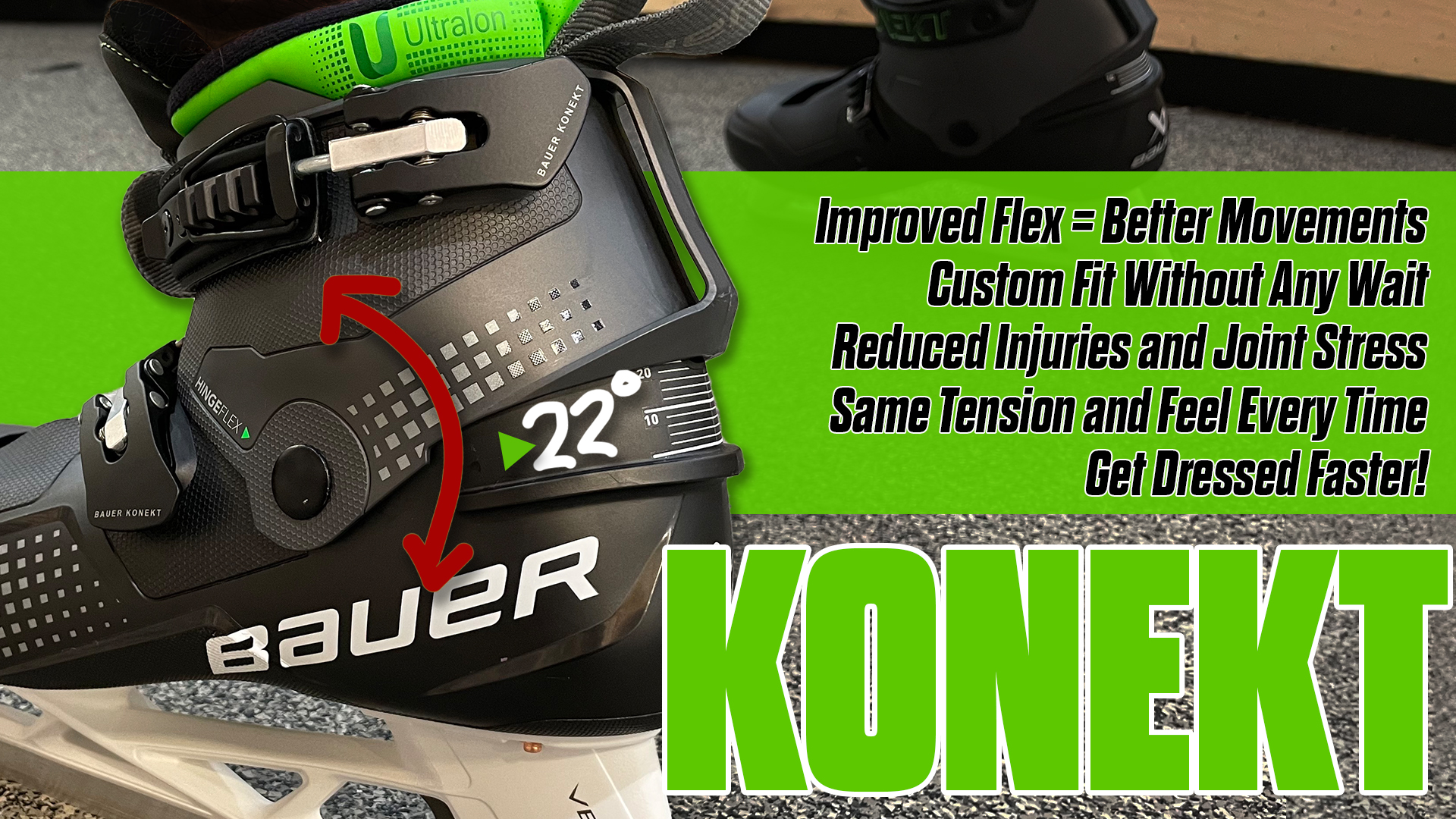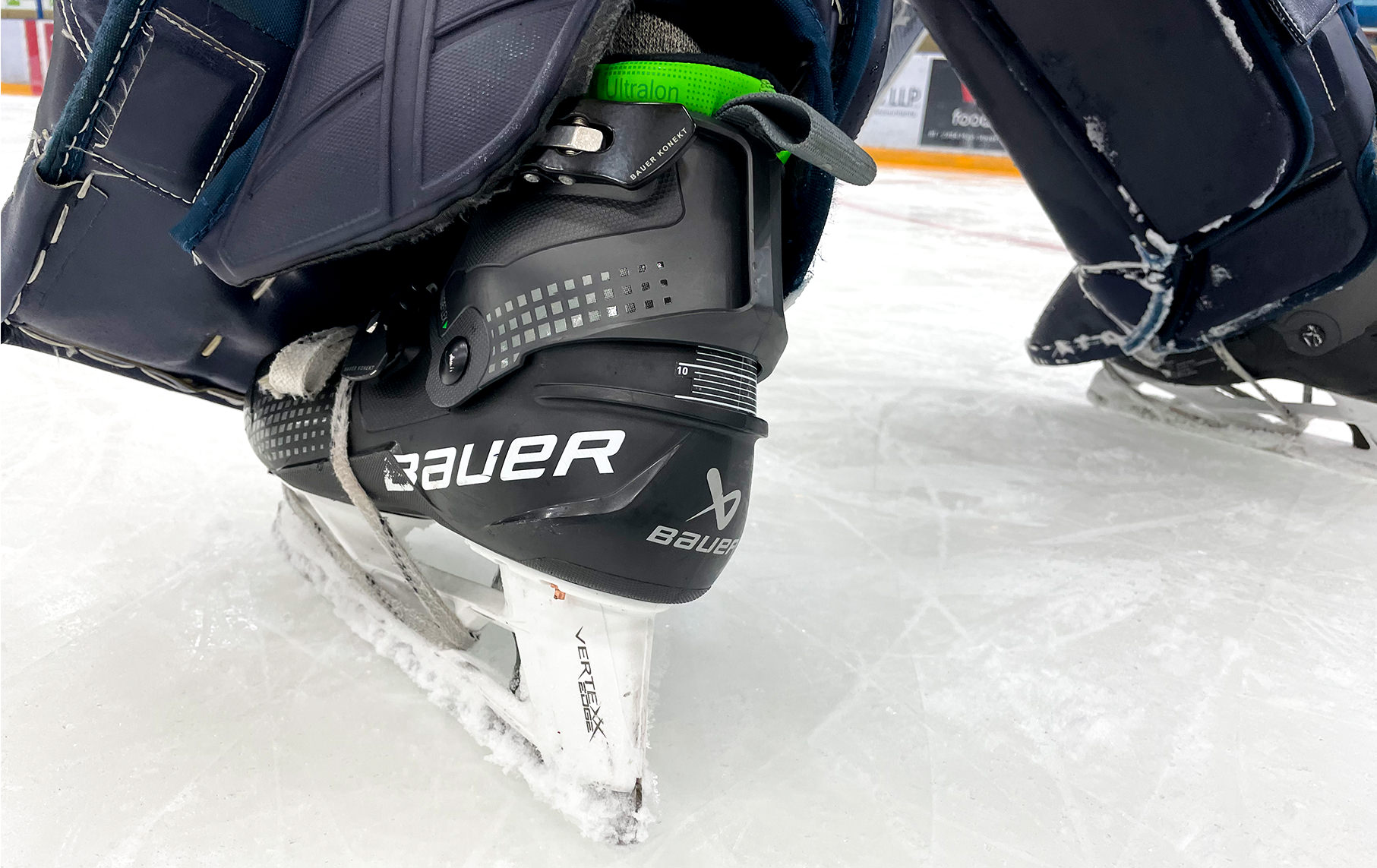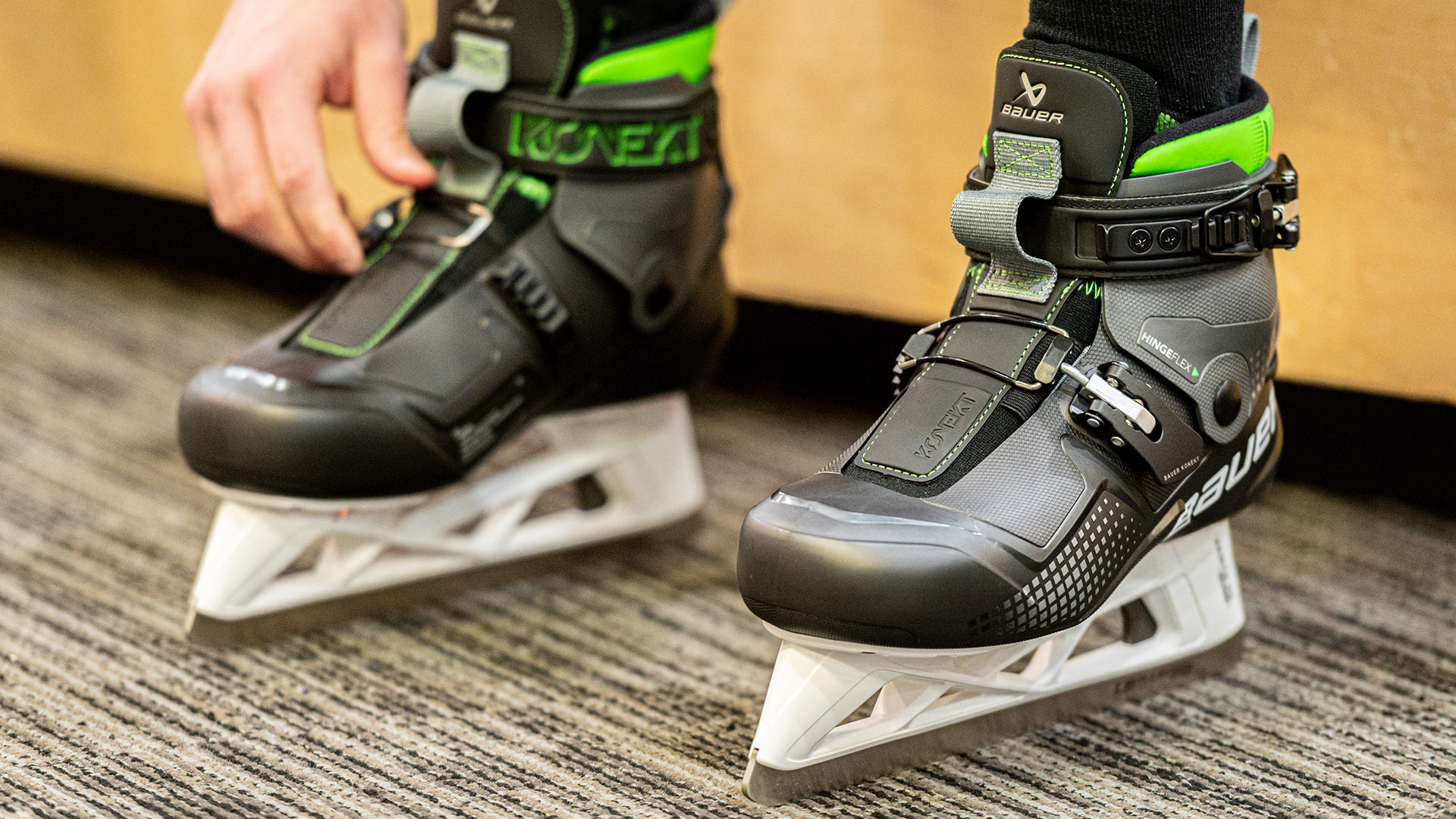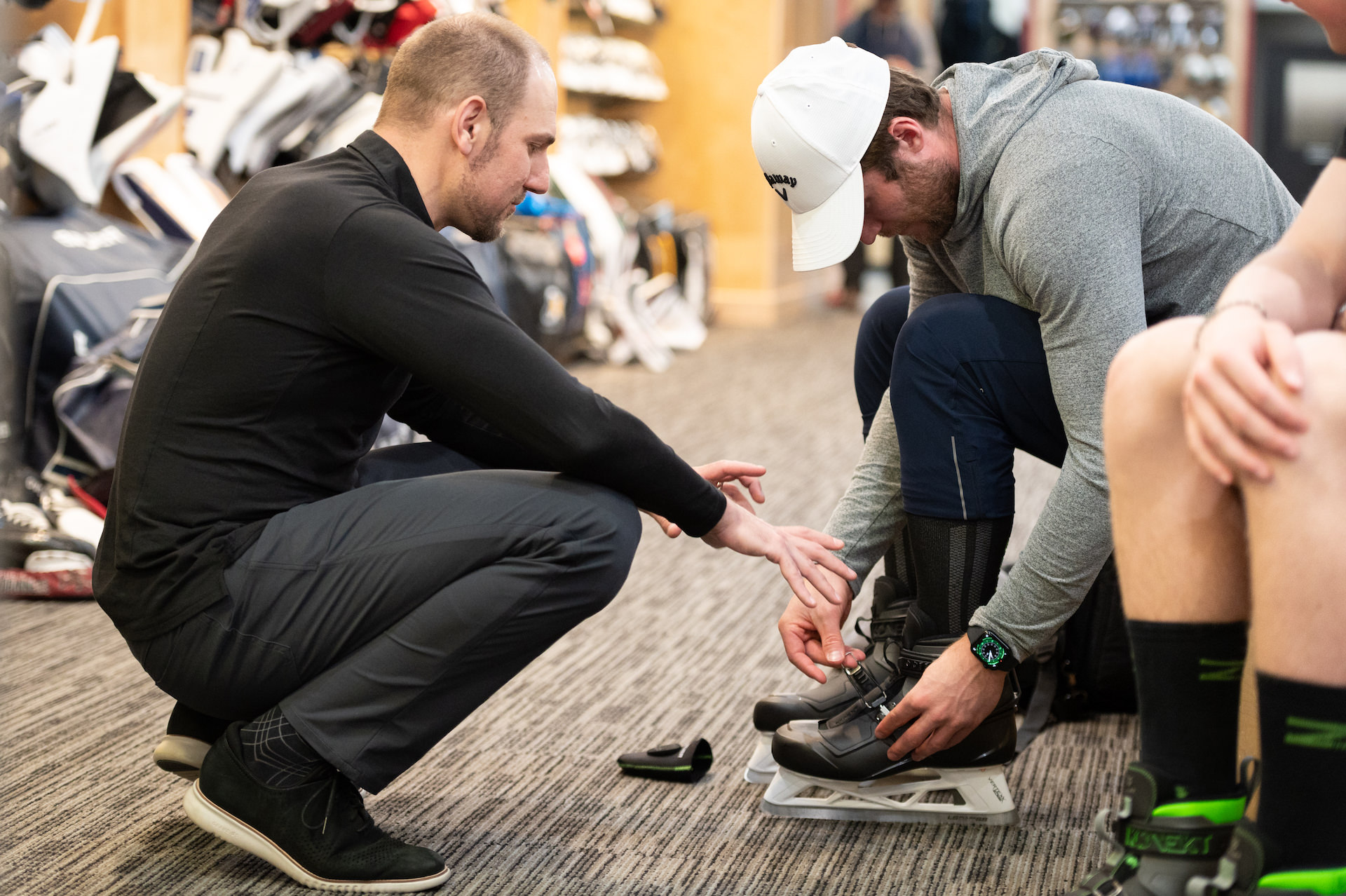
“What in the world are these? Freaking ski boots?”
Charlie Lindgren admits his first reaction to the KONEKT skates echoed some of the comment section replies from internet trolls, which ironically was one of the ways the Bauer goal team knew they were on the right track with their latest dramatic equipment change.
One year later, Lindgren is happy he was one of the first pro adopters of a revolutionary new skate that yes, does look like a ski boot with its hard shell and buckles because it has roots in the ski industry. He credits the switch last summer for a role in his breakout season with the St. Louis Blues organization that included a .958 save percentage in the NHL and helped earn the 28-year-old a three-year, $3.3-million contract to play for the Washington Capitals.
“I got on the ice and honestly right from the moment I stepped on, I started moving around and that forward flexion is just awesome and the way it’s always the same tightness every time,” Lindgren said. “From the first skate, it just worked for me and I still feel even more athletic but still I’m in control. It suits my game. When you’re down in the butterfly, you don’t have to move your leg as much to get an edge. With the forward flexion you can certainly dig in easier, and you don’t have to drive as hard just because of that boot and the way it moves.”

New Washington Capitals goaltender Charlie Lindgren wore Konekt last season in St. Louis and Springfield, where he helped his team to the AHL’s Calder Cup Final. Photo: Matthew Pearce/Icon Sportswire
KONEKT ALL ABOUT CONNECTION
Before we get into the backstory that led to such a dramatic departure for Bauer, some of the specifics of how they accomplished it, and more feedback from pros and testers on how it feels and performs, let’s take a minute to go over what exactly the KONEKT skate is all about.
As the name indicates, the goal was to improve the goalie’s connection with the ice by adding forward flex. In the process of achieving that, Bauer’s bold new direction also allowed them to create an almost instant custom fit in store without waiting for a custom ordered skate to be built and shipped, and may have also helped reduce wear and tear on the knees and hips.
Let’s focus on the flex first, since it’s the thing that jumps out first.
In recent years, the primary focus with goalie skates has been on creating a better fit, one that is not only comfortable but also reduces any lost energy transfer between the goalie’s foot and the blade on the ice. Few accomplished this better than True, who significantly increased their NHL presence with a one-piece skate that left some goalies feeling so connected to the ice they even changed their sharpening. But in the pursuit of no lost energy transfer, skates also got stiffer, and for many the only way to get forward flex was to leave the top eyelets undone.
Bauer’s goalie team set out to find a way to achieve more of that desired ankle flexion without sacrificing any of that tight, connected feeling between the foot, skate and ice.
In other words, how can we build a stiff skate that also flexes?

The Hingeflex mechanism allows the goaltender more flex at the ankle whether in movement or for a more natural stance position as seen here with WHL goaltender Matthew Kieper of the Regina Pats with a full 16 degrees of forward flex in his skate as seen on the scale at the back of the heel.
HINGEFLEX = 22 DEGREES OF FORWARD FLEX
By creating a more mechanical flex point at the ankle that Bauer calls Hingeflex, they were able to create 22 degrees of forward flex for goalies without needing to soften up any materials.
This feature is the primary driver of the rave reviews most goalies have shared with InGoal.
As Lindgren mentioned above, that ankle flexion allows goalies to grab and load a push edge from their butterfly without needing to raise their knee as high as they used to off the ice with a traditional skate, which created a more fixed angle between the skate and shin. Goalies also talked about feeling like they get more of the skate blade on the ice when making those pushes, rather than pushing with the toe of the blade, which also makes sense given the flex.
The idea of using ankle flex to more easily load a deeper, better push edge almost seems like a foreign concept, but Lindgren insisted it’s real and he noticed the difference right away.
“Oh yeah,” he said. “That’s the thing, it just feels like it’s saving me time, especially when I’m down and I’m moving in my butterfly. I don’t have to reach up as much with my leg. I can dig in so much easier and get a really solid push just because of that forward flexion.”
Having access to that forward flex can take a little getting used to from a standing position on the ice. While the natural pitch of the skate hasn’t changed at all from previous Bauer models – the KONEKT uses the same Vertexx Edge holder and the foot sits in it the same way at the bottom – the balance point is different and can takes some adjustment. InGoal testers talked about being able to shift their weight over their toes, and that making it easier to get into a lower save stance with their legs rather than bending at the waist (and as most modern goalie coaches will tell you, dropping your chest at the waist or hips is not a good thing). Bauer has used shims with some pros to reduce the amount of forward flex at first, but found most wanted the full flex pretty quickly, which echoes the experience of goalies we talked to.
“The balance point is completely unique and definitely gave me some issues at first on plays where I had to gain or give ground,” said John Hawthorne, who is coming off a .935 save percentage season and going into his senior NCAA season at Canisius College. “But I’ve gotten used to that now and grown to love the greater foot control the different balance provides.”
Achieving that flex used to mean wearing a softer boot (which one reason some goalies like Devan Dubnyk and Roberto Luongo remained in outdated models years after they were no longer available at retail), or not doing up the laces all the way on newer, stiffer skates.
KONEKT achieves it without having to sacrifice the benefits of a stiff, connected skate.
“My foot doesn’t feel like it’s slipping out of the boot,” Lindgren said. “I feel like I’m still locked in, but I feel like I’m on my toes in an athletic position, and I’m able to move really well.”
HOW BAUER DID IT: MATERIALS ARE KEY
The idea behind the KONEKT innovation echoes the playbook used with the original OD1N pad first worn by Henrik Lundqvist. Bauer didn’t want to build another “me too” product that echoed what others were doing, so they looked for unique ways to establish that forward flex without sacrificing the tight fit and control that comes with it. The skate team dusted off some old pairs of Micron and Lange skates as a concept of how to achieve it, and that led the goal team to a meeting with Jason Roe, a ski boot developer for Atomic Ski, who showed them the ins and out of the top materials being used in an industry that demands flex and control.
“We wanted to change the game with a crazy innovation by shocking people and getting the internet trolls going,” said Mark Gignac, the goalie category manager for Bauer. “That’s exactly what happened, just like OD1N, and we knew we were on the right track with KONEKT.”
That path started with sourcing the right materials with help from Roe.
They found the best material for combining thermoformable properties (needed to achieve the custom fit using only the heat of a skate oven) with durability and performance in cold weather was Grilamid, an expensive injected plastic material made by a company in Switzerland.
Sharks goaltender Kaapo Kahkonen takes advantage of the removable liner by swapping them each period so he is always playing in dry skates. Photo: Matthew Pearce/Icon Sportswire
That took care of the shell, but as you have likely already noticed, the inner liner is a separate piece in the KONEKT skate, and Bauer still needed a material that would combine comfort with some odor and moisture-repelling properties. Once again, they arrived at another staple of the ski boot industry in Ultralon, which also has some thermoformable properties that aid in the custom fit process. While the idea of a removable liner is unique — and perhaps seems strange — to the world of skates, they add the benefit of being replaceable, with extra liners sold separately if you want more than one. Kaapo Kahkonen of the San Jose Sharks, who along with Lindgren was an early adopter in the NHL, got three sets of liners, allowing him to swap in a new, dry set before each period in much the same way some NHL goalies rotate multiples gloves and blockers to keep the hands dry during a game. That may seem extreme but at the lower levels having a second (dry) liner can come in handy at tournaments with multiple games on the same day and not enough time or the right facilities to dry out your skates in between.
Last on the required list of new materials were the buckles, and again Bauer used the high-performance ski industry to find the right one, partnering with Gudo, an Italian company to create some ski-boot like clasps designed to endure the added stress of potential puck impacts (however rare and unlikely that may be given their location and how pads protect them). While the buckles are designed to create that same tight, connected fit skiers and goalies demand, with the top buckle locking in the ankle and the bottom one across the top of the foot helping to hold the heel in place, they come with a side benefit, one that echoes the trend towards Velcro straps on pads: it’s a lot easier and faster to get dressed and undressed.
“I’m sure we’ll see a lot more coaches in them just because it’s takes about five seconds to throw them on,” Lindgren said. “That’s fun, too. I haven’t tied laces since August 2022.”

With materials borrowed from the ski boot industry, Konekt gives goalies a custom fit in the store, the same feel every time they put them on and of course a quick change as a bonus!
CAN A SKATE HELP YOUR HIPS?
The idea that ankle flex might also help reduce wear and tear in the hips wasn’t something we went into the testing phase expecting, but after hearing similar sentiments from Lindgren, Hawthorne and a couple other younger testers, it had to be mentioned.
That is especially true given some of the concerns we’ve heard from NHL goalie coaches about a rise in injuries they think might be tied to the trend towards stiff skates chasing the “no lost energy transfer” mantra. With the angle between the foot and shin more fixed in those newer, stiffer traditional skates, all that energy has to go somewhere when you slide into a post, or grab an edge to stop a powerful lateral slide in the butterfly, and some coaches are concerned its going up the chain into the knees and hips, a concern mentioned to Elliotte Friedman for one of his weekly 32 Thoughts columns on Sportsnet this season. If that theory is correct, would goalies in KONEKT notice less stress on knees and hips because of the give in the ankle?
“Oh, yeah,” Lindgren said. “The last couple of years my ankles I felt would get tight and that would translate up — it’s all a chain — and then my hips would get tight. My body felt great this year, my hips felt awesome, and I think it’s because of that mobility, and the ability for my ankle to be able to have that movement where it’s not so locked in that I feel super tight.”
Again, it’s just anecdotal evidence, but Hawthorne echoed those sentiments.
“Particularly as somebody who has dealt with hip problems, the extra ankle mobility is wonderful,” he said. “The fit is great, probably the best-feeling Bauer I’ve had.”
CUSTOM FITTING WITHOUT THE WAIT
That great fit Hawthorne describes is largely a result of the materials being used.
The ability to mold the Grilamid using a skate oven is actually pretty remarkable to see for the first time. One goalie at a pro fitting InGoal attended in Vancouver struggled to even get his foot into the shell wearing the liner before they were heated but easily slid it in after (this seems like a good spot to note that trying it on in store by sliding your foot into the liner and sliding that into the shell without heating it up first is not the best way to proceed, and if that’s what the salesperson suggests, you might need to find someone with a better idea how these are supposed to be fitted properly).
That high degree of moldability is what makes KONEKT an in-store custom skate option.
It starts by removing the Ultralon liner and placing the Grilamid shell into the skate over for seven minutes, then adding the liner and baking them together for another four. At that point (using gloves provided by Bauer to prevent getting burned by the buckles), goalies should put the liner on, then holding onto it with the loop atop the heel while sliding their foot into the shell. This helps make sure the heel stays locked into the back of the skate. Goalies will be asked to put a sleeve, also provided by Bauer, over their toes before putting the liner on, which helps make sure there is enough space at the front of the skate as it cools around the foot.

Similarly, you can add shim pads to any spots that caused you problems with skate fitting in the past because they stick out, and those pads will also create extra space in the shell as it cools. If you use a custom footbed or orthotics, put them in the liner too before sliding it into the shell. You may find you don’t need it, but if you’ve used them a long time, continuing to do so by putting them inside Bauer’s Ultralon liner will give you the same feel and stance posture.
Retailers should also have access to a customized ice gel pack that wraps and secures around the skate to aid in the cool-down process, which should be roughly 11 minutes and is typically spent in a sitting position. One exception to that is wider feet that produce signs of tension in that lower buckle, in which case standing up for a couple minutes at the beginning of that 11-minute cooling process can help spread out that lower part of the shell while it’s still soft.
For similar reasons, Bauer advises not over-tightening that lower buckle while it cools, leaving a little space that can be cinched tight later with the buckle rather than locking it into the tightest/narrowest fit position by holding it there during the cooling process. They also suggest walking that top buckle tighter as it cools, moving it one slot at a time. The adjustability of the buckles isn’t limited to the four clamp slots; you can also make micro-adjustments by twisting the buckle (right to tighten, left to loosen) but be careful to make sure the correct side if facing out (there are arrows to help) before clamping it shut or you could break the buckle.
Once the KONEKT is cool to the touch on the bottom of the shell, take the shims and toe sock out, which will relax the fit a bit, and you are good to hit the ice and start skating.
As a bonus, once you get your fit dialled in how you like it, you can leave it there and expect the same feel every time you hit the ice, a level of consistency that any goalie who has found the pulled a lace too tight or left one too loose only after they step on the ice.
SIZING LIMITATIONS AND FIT FEEDBACK
As exciting as it is to get a custom in store, one downside to the new KONEKT fitting process is it’s not really a do-it-yourself at home process so ordering online doesn’t really work here.
The Grilamid shell only comes in full sizes, not half sizes, but the nature of how the KONEKT skate fits means that isn’t as big a deal as it would be in a traditional boot. The KONEKT also isn’t available in youth sizes and for now is senior sizing only, starting with a size 7.
Speaking of fit, we have run into a couple of goalies with wider or unusually shaped feet who struggled with the bottom buckle creating a pinch or discomfort across the top of their foot, including one pro that loved the performance aspect but struggled enough with that fit issue he went back to his old skates. It’s possible to re-bake the shell several times as well, adding those padded shims to new areas as you work through any tight spots or pinch points. One solution that worked for another goalie who experienced a similar thing was to go up one shell size, while keeping the same liner size (you can mix and match these), which created more space.
That extra length in the shell may also help with one of the few performance critiques we’ve heard so far: goalies playing at junior or above said they feel shots off the toe more.
That was also true of Lindgren, who might look at a bigger shell this summer too.
“The one thing I don’t like about them is I’m getting a lot of stingers off the toes this year,” said Lindgren. “But I can deal with that just because I love to skate so much.”
Lindgren thinks you’ll see a lot more goalies joining him in KONEKT soon.
COVID-19 protocols limited the NHL roll out last season because border issues made it harder to custom fit goalies, but Andrei Vasilevskiy finally got to try them in mid-December after a visit to Ottawa with the Tampa Bay Lightning. and quickly joined Lindgren and Kahkonen by wearing them all the way to the Stanley Cup Final. Expect to see more goalies, headlined by Jake Oettinger of the Dallas Stars, wearing KONEKT in the NHL this season.
Curiosity is quickly turning into KONEKT converts.
“Early on I’m throwing these on and guys are like, ‘are you serious with that? What are you doing putting those on?’” Lindgren said. “And I’m like, ‘honestly, I love them.’”
Tampa Bay Lightning Goaltender Andrei Vasilevskiy in the Bauer Konekt during the 2022 Stanley Cup Final.
Photo: Andrew Bershaw/Icon Sportswire



Wow, these remind me so much of the Lange hockey skates made back in the 70s and early 80s, I’m probably dating my age here but I had Lange goalie skates playing in prep school and those skates were by far the most comfortable skates I have ever worn, you’d have to replace the liners every year but these are definitely what Lange goalie skates would be in the year 2022!
Us too Robbie!! Miss our Langes so much (but must say we didn’t know the liners could be replaced so ours were well worn in!)
On thing that will also help reduce tension on hips/ankles is the trend to have very tall edge holders seems to have gone down. the taller your edge holder, the lower and wider you can get in your stance… at the expense of lots of tension. You need to lift your leg higher to grab an edge when in the butterfly (tension) and transitions into rvh are more painful
Yep
I’m a 76-year-old goaltender using Bauer Vapor goalie skates. I lace them to the top and very tight to get the bite I need to push off. I read the article on the new Bauer Konekt skate. I’m sure my flex angle is not a perfect 14 degrees. Two questions. Is it wrong to lace up and tight? Would the new Bauer Konekt be better for me? I played for team USA 80+ in Burlington Ontario against the Canada 80+ team for the Canada 150 Cup in October and got a big blister on my left ankle. I was sure this was caused by my skate being laced too loose. Any advice?
Hi Larry, thanks for hopping in the comments. First off I wouldn’t say there is a “perfect” flex angle. That surely is a personal decision based on your own body and your preferred stance.
I don’t think lacing tight is wrong…again it’s personal. Are you comfortable and able to move as you like? I do think if you like them tight the Konekt would allow you to flex and get to some different positions when the skate is tight – whereas a traditional skate laced tight would restrict you to one.
PS – congratulations on the big tournament – I enhjoyed reading this article about you: https://www.laconiadailysun.com/news/local/team-usa-over-80-wins-international-hockey-competition/article_a3df52c4-8892-11ee-a164-6b80f8ec388f.html
sounds like you and Woody took up the position at a similar age!